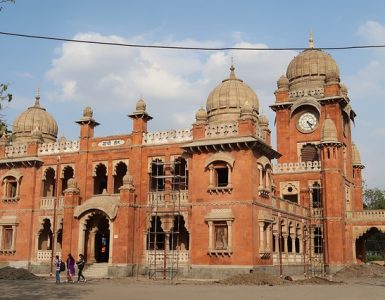Last year in March 2023, India’s environment ministry launched an ambitious green wall project that aims to plant native species of trees across an area that will be 1400 km long and 5 km wide.
This is India’s first attempt to create a green wall and it will come up in the Aravalli Mountain Range, which is an important ecological zone in the country.
Aravalli Hill runs across four Indian states – Haryana, Rajasthan, Gujarat, and Delhi, and is extremely significant to India’s geology. The mountain range stretches for about 700 km in a southwest direction and consists of a hybrid terrain of valleys, hills, plateaus, ridges, and mountain peaks.
As you know, India’s geography is incredibly diverse with many different terrains and landscapes, including a vast desert.
Thar Desert is India’s largest desert and the 18th largest desert in the world. This large Indian desert could have spread to a larger area in the country if it were not for the Aravalli Hills.
These hills act as the barrier that separates the Thar desert in its east and the plains in the west. Aravalli Hills act as a barrier against the wind, carrying sand from the Thar desert and preventing it from entering the eastern region, thus curbing the spread of the desert.
The hills also act as a river catchment area where water collects when it rains, thus giving rise to several rivers, including the Banas, Luni, Sakhi, and Sabarmati. This provides a conducive environment for lush green forests, vibrant flora, and diverse wildlife. Apart from offering a rich biodiversity, Aravalli Hills is a treasure trove of rich mineral resources like copper, zinc, lead, and marble.
These abundant resources made Aravallis a happy hunting ground for early humans. Archeological excavations have revealed that Aravalli has seen human settlements from Stone Age times.
As time went by, the region played host to many kingdoms and rulers, who built countless palaces, forts, and temples on the Aravalli. These majestic monuments showcase the rich cultural and historical heritage of the region.
Many of these buildings still stand and are UNESCO World Heritage sites with millions of visitors flocking to them. A few notable buildings that stand on the Aravalli mountains are Kumbhalgarh Fort, which has the second longest wall in the world after the Great Wall of China, Chittorgarh Fort, Ranthambore Fort, Gagron Fort, Amer Fort, and Dilwara Temples.
However, to construct these buildings tonnes of marble and other mineral resources were mined from the Aravalli Hills. Minerals were also extracted for trade and economic activities. In fact, the mining of copper in the Aravalli range dates back to at least the 5th century BCE.
Add to that, the industrialization era brought rapid urbanization, unplanned infrastructure development, inefficient waste management, and industrial pollution to the region.
The Aravalli Hill which was once an ecology hotspot started to lose its greenery and the land was depleted.
As per the reports, in the last four decades, forests in the Aravallis have reduced by 7.6 percent. The study has also indicated that the Thar desert is gradually advancing towards Eastern Rajasthan, Haryana, and the national capital. Another news report suggests that more than 30 hills have disappeared in Rajasthan due to illegal mining.
These are startling findings and needed an urgent course correction.
That’s where the plans to create a Green Wall on Aravalli Hills fit in. The project will be spread over 75 villages around the Aravalli Range and include planting native plant species on scrubland, wasteland, and degraded forests. It will also focus on restoring water bodies such as ponds, lakes, and streams.
The objective of the Green Wall is to increase the green cover and biodiversity of the Aravalli and improve the soil fertility, water availability, and climate resilience of the region. The project will also benefit the local communities by providing them with employment opportunities, income generation, and ecosystem services.
The project was conceptualized on the lines of the African Green Wall program, which stretches over 8,000 kilometers across more than a dozen countries from Senegal in West Africa to Djibouti in the East. This African green belt launched in 2007 was meant to act as a defensive flank against climate change, desertification, and other forms of land degradation. The project has fallen short of its targets due to a lack of coordination among the countries involved.
The successful implementation of the Green Wall on Aravalli Hills can serve as a model for other regions facing similar issues.
Wrapping Up
Aravalli hills are an important natural and cultural heritage of India, playing a crucial role in shaping the geography, culture, and lifestyle of the people living in the region. It is essential to take immediate action to protect these hills from further degradation and conserve them for future generations to enjoy.






Add comment